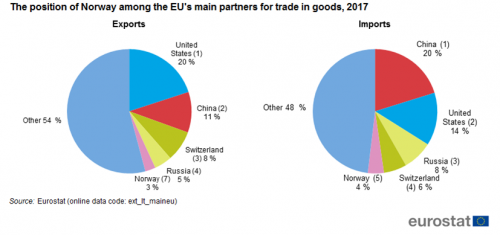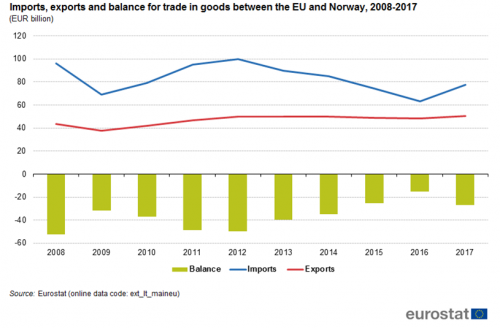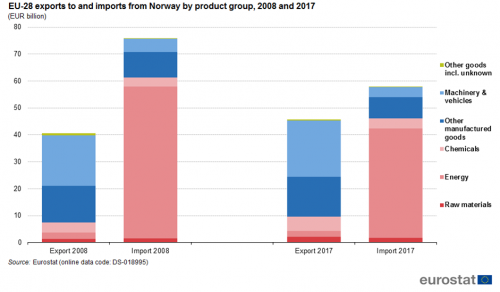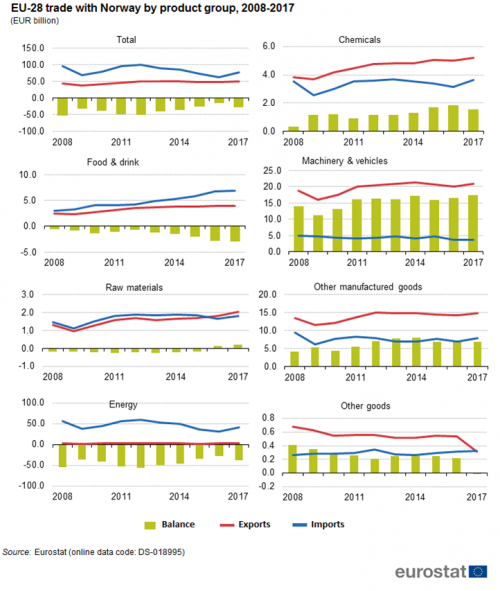Archive:Norway-EU - international trade in goods statistics
Data extracted in April 2018
Planned article update: April 2019
Highlights
Imports, exports and trade balance in goods between the EU and Norway, 2008-2018
This article provides a picture of the international trade in goods between the European Union (EU) and Norway. It analyses the type of goods exchanged between the two economies and the shares of each EU Member State in those exchanges.
This article is part of an online publication providing recent statistics on international trade in goods, covering information on the EU's main partners, main products traded, specific characteristics of trade as well as background information.
Full article
Overview
- In 2016, Norway was the 23rd largest exporter of goods in the world with a share of 0.7 % of world exports and the 25th largest importer of goods with a share of 0.6 % of world imports.
- In 2017, Norway was the 7th largest partner for exports of goods from the EU and the 5th largest partner for imports of goods to the EU.
- The EU's trade in goods deficit with Norway has fallen from EUR 52 billion in 2008 to EUR 27 billion in 2017.
- 81 % of EU exports of goods to Norway are manufactured goods while over half of EU imports of goods from Norway are energy products.
- In 2017, the United Kingdom was the largest importer of goods (EUR 21 billion) from Norway and had the largest trade in goods deficit (EUR 18 billion).
- Sweden was the largest exporter of goods (EUR 14 billion) to Norway and had the largest trade in goods surplus (EUR 3 billion).
EU and Norway in world trade in goods
The four largest exporters of goods account for almost half of the world exports (Figure 1a). The largest is China (17 %) followed by the EU (16 %), the United States (12 %) and Japan (5 %). The same four also account for almost half of the world imports of goods but in a different order. Here the United States (18 %) leads, followed by the EU (15 %), China (12 %) and Japan (5 %). Figure 1b has more details, showing that with EUR 81 billion Norway is the 23rd largest exporter of goods, placed between Turkey (EUR 129 billion) and South Africa (EUR 67 billion). In imports of goods, Norway is 25th with EUR 66 billion, just below South Africa (EUR 68 billion).

Source: Eurostat (ext_lt_introle)

Source: Eurostat (ext_lt_introle)
The evolution of trade in goods in the EU and Norway over the period 2007-2016 is the focus of Figure 2. Between 2007 and 2012 both export and imports of the two economies followed a similar pattern: a dip in 2009 followed by a recovery. After 2012 imports of both economies remained fairly stable but exports moved in opposite directions. EU exports fluctuated while Norway's exports fell to 19 percentage points below their 2007 level. Consequently Norway's cover ratio dropped from 170 % in 2007 to 123 % in 2016. In the same period, the EU's cover ratio grew from 85 % to 102 % meaning that the trade deficit was turned into a trade surplus.

Source: Eurostat (ext_lt_introle)
EU trade in goods deficit fell by two thirds since 2008
Norway's trade in goods compared to the top four trading partners of the EU, which were the United States, China, Switzerland and Russia, is shown in Figure 3a. These four made up 43 % of all exports of goods from the EU and 48 % of all imports of goods to the EU. There is more detail in figure 3b which shows that in 2017, Norway (EUR 51 billion) was the EU's seventh largest export of goods destination, placed between Japan (EUR 60 billion) and South Korea (EUR 50 billion). In EU imports of goods, Norway's EUR 77 billion placed it fifth, between Switzerland (EUR 110 billion) and Turkey (EUR 70 billion).

Source: Eurostat (ext_lt_maineu)

Source: Eurostat (ext_lt_maineu)
The EU recorded a trade in goods deficit with Norway from 2007 to 2017 (see Figure 4). In this time span, trade in goods between the two economies hit a low in 2009, but soon recovered, peaking in 2012 after which exports to Norway remained stable while imports from Norway started falling. They reached a low point of EUR 63 billion in 2016 but recovered again to EUR 77 billion in 2017. Due to the falling imports the trade deficit fell from EUR 52 billion in 2008 to EUR 27 billion in 2017.

Source: Eurostat (ext_lt_maineu)
Manufactured goods dominate exports to Norway
When breaking down imports and exports by SITC groups, the main categories driving exports to Norway are 'Machinery and vehicles' (41 %), 'Other manufactured goods' (29 % ) and 'Chemicals' (10 %) . Together these manufactured goods made up more than 80 % of EU exports in 2017 (see Figure 5). In contrast, manufactured goods made up only 20 % of imports from Norway, while energy products made up 52 %.

Source: Eurostat DS-018995
The evolution of EU imports and exports by SITC group since 2008 is shown in Figure 6. The EU has a large trade deficit in 'Energy' and a smaller deficit in 'Food & drink'. The EU has large trade surpluses with Norway in 'Machinery and vehicles', 'Other manufactured goods' and a small surplus in 'Chemicals'. Finally in 'Raw materials' and 'Other goods' imports and exports are almost equal.

Source: Eurostat DS-018995
Most traded goods: energy products
More details about the goods exchanged between the EU and Norway are given in Figure 7, showing the top 20 traded goods at a more detailed level (by SITC level 3). Those top 20 goods covered a little over half of total traded goods in 2017. Eight products among the top 20 belong to the 'Machinery & vehicles' group and four to 'Energy'. Crude petroleum and natural gas were the top two products.
Another interesting way to look at data is to investigate the export/import ratio of traded goods, in order to better identify the direction taken by flows and specialisation between the two areas. These ratios can be found in the right margin of Figure 7. There were six products with a ratio below 100 of which five (crude petroleum, natural gas, fish, aluminium and liquefied propane and butane) were below 10, indicating far larger imports to the EU from Norway than exports from the EU to Norway. For all other products in the top 20 the ratios were above 100, most notably in motor cars and vehicles.

Source: Eurostat DS-018995
North Sea countries trading most with Norway
Figure 8a shows EU Member States' imports of goods from Norway and the share of the partner Norway in national extra-EU imports of goods in 2017. Figure 8b provides similar information but concerning EU Member States' exports of goods to Norway.
There were four Member States whose imports of goods from Norway were higher than EUR 10 billion: the United Kingdom (EUR 21 billion), Germany, the Netherlands (both EUR 13 billion) and Sweden (EUR 10 billion). Denmark (5 billion) completed the top five who were all located on the border of or close to the North Sea. Together these five accounted for 81 % of all EU imports from Norway. Norway is an important trade partner for Sweden and Denmark who respectively get 26 % and 21 % of their extra-EU imports from Norway.
The same five Member States were also the largest exporters of goods to Norway in 2017, but in a different order, with Sweden (EUR 14 billion) being the top exporter and the only one above EUR 10 billion. Their combined share in exports to Norway was 71 %. Four Member States have more than 10 % of their extra-EU exports with destination Norway. These are Sweden (25 %), Denmark (16 %), Estonia (14 %) and Cyprus (11 %).
In 2017, eight Member States had a trade in goods deficit with Norway in 2017 (Figure 8c), ranging from EUR 39 million for Greece to EUR 17.7 billion for the United Kingdom. The Netherlands (EUR 8.1 billion), Germany (EUR 4.3 billion), Belgium (EUR 2.7 billion) and Spain (EUR 1.0 billion) also had deficits of more than EUR 1 billion. The remaining 20 Member States had a trade surplus, starting at EUR 1 million for Malta to EUR 3.4 billion for Sweden.

Source: Eurostat DS-018995
Source data for tables and graphs
Data sources
EU data is taken from Eurostat's COMEXT database. COMEXT is the reference database for international trade in goods. It provides access not only to both recent and historical data from the EU Member States but also to statistics of a significant number of third countries. International trade aggregated and detailed statistics disseminated via the Eurostat website are compiled from COMEXT data according to a monthly process.
Data are collected by the competent national authorities of the Member States and compiled according to a harmonised methodology established by EU regulations before transmission to Eurostat. For extra-EU trade, the statistical information is mainly provided by the traders on the basis of customs declarations.
EU data are compiled according to Community guidelines and may, therefore, differ from national data published by the Member States. Statistics on extra-EU trade are calculated as the sum of trade of each of the 28 EU Member States with countries outside the EU. In other words, the EU is considered as a single trading entity and trade flows are measured into and out of the area, but not within it.
Data for the other major traders are taken from the Comtrade database of the United Nations. Data availability differs among countries, therefore Figure 1 shows the latest common available year for all the main traders. For the calculation of shares world trade is defined as the sum of EU trade with non-EU countries (source: Eurostat) plus the international trade of non-EU countries (source: IMF Dots database).
Methodology
According to EU concepts and definitions, extra-EU trade statistics (trade between EU Member States and non-EU countries) do not record exchanges involving goods in transit, placed in a customs warehouse or given temporary admission (for trade fairs, temporary exhibitions, tests, etc.). This is known as 'special trade'. The partner is the country of final destination of the goods for exports and the country of origin for imports.
Product classification
Information on commodities exported and imported is presented according to the Standard international trade classification (SITC). A full description is available from Eurostat's classification server RAMON.
Unit of measure
Trade values are expressed in millions or billions (109) of euros. They correspond to the statistical value, i.e. to the amount which would be invoiced in the event of sale or purchase at the national border of the reporting country. It is called a FOB value (free on board) for exports and a CIF value (cost, insurance, freight) for imports.
Context
Trade is an important indicator of Europe's prosperity and place in the world. The bloc is deeply integrated into global markets both for the products it sources and the exports it sells. The EU trade policy is an important element of the external dimension of the 'Europe 2020 strategy for smart, sustainable and inclusive growth' and is one of the main pillars of the EU's relations with the rest of the world.
Because the 28 EU Member States share a single market and a single external border, they also have a single trade policy. EU Member States speak and negotiate collectively, both in the World Trade Organization, where the rules of international trade are agreed and enforced, and with individual trading partners. This common policy enables them to speak with one voice in trade negotiations, maximising their impact in such negotiations. This is even more important in a globalised world in which economies tend to cluster together in regional groups.
The openness of the EU's trade regime has meant that the EU is the biggest player on the global trading scene and remains a good region to do business with. Thanks to the ease of modern transport and communications, it is now easier to produce, buy and sell goods around the world which gives European companies of every size the potential to trade outside Europe.
Direct access to
- International trade in goods (t_ext_go), see:
- International trade in goods - long-term indicators (t_ext_go_lti)
- International trade in goods - short-term indicators (t_ext_go_sti)
- International trade in goods (ext_go), see:
- International trade in goods - aggregated data (ext_go_agg)
- International trade in goods - long-term indicators (ext_go_lti)
- International trade in goods - short-term indicators (ext_go_sti)
- International trade in goods - detailed data (detail)
- EU trade since 1988 by SITC (DS-018995)
- International trade in goods statistics - background
- International trade in goods (ESMS metadata file — ext_go_esms)
- User guide on European statistics on international trade in goods
- European Commission

